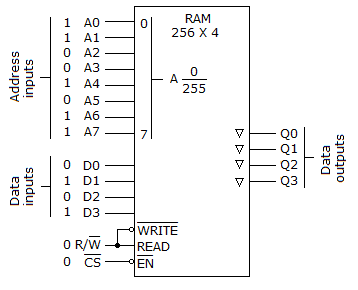Discussion
Home ‣ Digital Electronics ‣ Memory and Storage See What Others Are Saying!
- Question
The smallest unit of binary data is the ________.
Options- A. bit
- B. nibble
- C. byte
- D. word
- Correct Answer
- bit
- 1. VARIABLES are considered to be updated ________ within a sequence of statements in a PROCESS, whereas SIGNALS referred to in a PROCESS are updated when the PROCESS ________.
Options- A. once, starts
- B. immediately, suspends
- C. twice, ends
- D. never, starts Discuss
- 2. After 10 clock cycles, and assuming that the DATA input had returned to 0 following the storage sequence, what values would be stored in Q4, Q3, Q2, Q1, Q0 of the register in Figure 7-5?
Options- A. 0,1,0,1,1
- B. 1,1,0,1,0
- C. 1,0,1,0,1
- D. 0,0,0,0,0 Discuss
- 3. The RAM circuit given below is suspected of being bad. A check with a logic probe shows pulse activity on all of the address lines and data inputs. The / line and inputs are forced HIGH and the data output lines are checked with the logic probe. Q0, Q2, and Q3 show a dim indication on the logic probe; Q1 indicates a HIGH level on the logic probe. What, if anything, is wrong with the circuit?

Options- A. The Q0, Q2, and Q3 output lines are open; the chip is defective.
- B. The Q1 line appears to be shorted to Vcc; replace the chip.
- C. The outputs should be active only when the / line is held LOW, so the circuit is behaving normally considering the fact that the line is HIGH.
- D. The EN input should be forced HIGH and the outputs rechecked; if they are still giving the same indications as before, then the three outputs are definitely open and the IC will have to be replaced. Discuss
- 4. The 8-bit address bus allows access to an address range of:
Options- A. 0000 to FFFFH
- B. 000 to FFFH
- C. 00 to FFH
- D. 0 to FH Discuss
- 5. A circuit that responds to a specific set of signals to produce a related digital signal output is called a(n):
Options- A. BCD matrix
- B. display driver
- C. encoder
- D. decoder Discuss
- 6. A full adder has a carry-in.
Options- A. True
- B. False Discuss
- 7. A logic analyzer is used to display a timing diagram.
Options- A. True
- B. False Discuss
- 8. In Boolean algebra, the word "literal" means ________.
Options- A. a product term
- B. all the variables in a Boolean expression
- C. the inverse function
- D. a variable or its complement Discuss
- 9. Which of the statements below best describes the basic operation of a dual-slope A/D converter?
Options- A. The input voltage is used to set the frequency of a voltage-controlled oscillator (VCO). The VCO quits changing frequency when the input voltage stabilizes. The frequency of the VCO, which is proportional to the analog input voltage, is measured and is displayed on the digital display as a voltage reading.
- B. A ramp generator is used to enable a counter through a comparator. When the ramp voltage equals the input voltage, the counter is latched and then reset. The counter reading is proportional to the input voltage since the ramp is changing at a constant V/second rate.
- C. A ramp voltage and analog input voltage are applied to a comparator. As the input voltage causes the integrating capacitor to charge, it will at some point equal the ramp voltage. The ramp voltage is measured and displayed on the digital panel meter.
- D. Two ramps are generated: one by the input voltage and the other by a reference voltage. The input voltage ramp charges the integrating capacitor, while the reference voltage discharges the capacitor and enables the counter until the capacitor is discharged, at which time the counter value is loaded into the output latches. Discuss
- 10. One application of a digital multiplexer is to facilitate:
Options- A. data generation
- B. serial-to-parallel conversion
- C. parity checking
- D. data selector Discuss
More questions
Correct Answer: immediately, suspends
Correct Answer: 0,0,0,0,0
Correct Answer: The Q1 line appears to be shorted to Vcc; replace the chip.
Correct Answer: 00 to FFH
Correct Answer: encoder
Correct Answer: True
Correct Answer: True
Correct Answer: a variable or its complement
Correct Answer: Two ramps are generated: one by the input voltage and the other by a reference voltage. The input voltage ramp charges the integrating capacitor, while the reference voltage discharges the capacitor and enables the counter until the capacitor is discharged, at which time the counter value is loaded into the output latches.
Correct Answer: data selector
Comments
There are no comments.More in Digital Electronics:
Programming
Copyright ©CuriousTab. All rights reserved.
